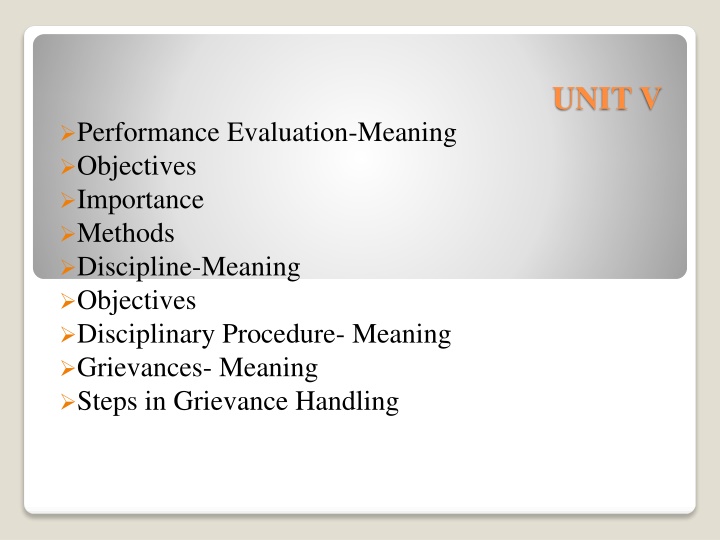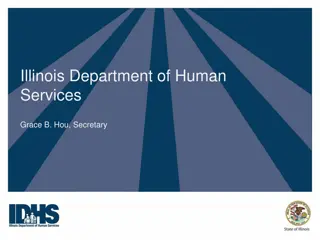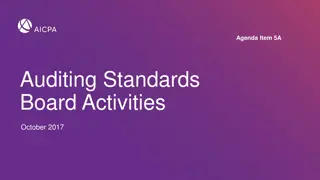
Performance Evaluation, Discipline, and Grievance Handling in Organizations
Understand the significance of performance evaluation for assessing employee progress, the importance and objectives of discipline, and the steps involved in grievance handling within organizations. Explore various methods of performance appraisal and the key objectives of discipline in ensuring employee cooperation and rule adherence.
Download Presentation

Please find below an Image/Link to download the presentation.
The content on the website is provided AS IS for your information and personal use only. It may not be sold, licensed, or shared on other websites without obtaining consent from the author. If you encounter any issues during the download, it is possible that the publisher has removed the file from their server.
You are allowed to download the files provided on this website for personal or commercial use, subject to the condition that they are used lawfully. All files are the property of their respective owners.
The content on the website is provided AS IS for your information and personal use only. It may not be sold, licensed, or shared on other websites without obtaining consent from the author.
E N D
Presentation Transcript
UNIT V Performance Evaluation-Meaning Objectives Importance Methods Discipline-Meaning Objectives Disciplinary Procedure- Meaning Grievances- Meaning Steps in Grievance Handling
Performance Evaluation- Meaning It is the process of making an assessment of the performance and progress of the employees of an organization. Performance evaluation is the assessment of an individual s performance in a systematic way.
To compensation packages, wage structure, salaries raises etc. To identify the strengths employees to place right men on right job. To maintain and assess the potential present in person for further growth and development. To provide a feedback to employees regarding their performance and related status. To review and retain the promotional and other training programmes. maintain records in order to determine and weaknesses of
Methods of Performance Appraisal Ranking method Graphic scale rating method- Forced choice method Essay appraisal method Paired comparison method Field review method Critical incidents method
Process of Performance Evaluation Job analysis Establishing performance standards Communicating the standards Determining the actual performance Matching the actual with the desired performance Discussing results Decision making
Discipline- Meaning The attitude of the employees with reference to the rules and regulations of an organization is what is termed as discipline. Employees are disciplined if they adhere to those rules and regulations and are in disciplined if they don t
Objectives To secure the co-operation of employees To ensure adherence to the rules and regulations of the organization To ensure goal attainment differences To develop a spirit of tolerance among the employees To have good human relations in the workplace To entrust responsibility To improve the morale of employees despite individual
A disciplinary procedure is a process for dealing with perceived employee misconduct. Organizations will typically have a wide procedures to invoke depending on the severity of the transgression. range of disciplinary
Objectives To enforce rules and regulations To punish the offender To serve as an example to others to strictly follow rules To ensure the smooth running of the organization To increase working efficiency To maintain industrial peace To improve working relations and tolerance To develop a working culture which improves performance.
Issuing a letter of charge Suspension pending enquiry Notice of enquiry Enquiry Recording the findings Awarding punishment
Grievance- Meaning A grievance is any dissatisfaction or feeling of injustice having connection with one s employment situation which is brought to the attention of management. A dissatisfied employee is bound to have grievances. Grievances, thus, arises due to the gap between the expectations of an employee and the extent of their fulfillment.
Cause of Grievances Unsuitable job Inadequate pay No guaranteed minimum wage Lack of job security Lack of social security benefits Inadequate Leave Facilities Lack of Incentives Lack of Promotion opportunities Irrational transfer policy of the employer Poor Working condition Poor superior-subordinate relationships
Identify grievances by the management through observation, previous surveys, interview etc. Define Correctly- Define the problem properly and accurately Collect Data- it involves collection of information from all the parties concerned Analyze and Solve-It involves information and development of various alternative solutions to the grievances through group discussions and brainstorming Prompt Redressal- It involves implementation of the solution selected by the management Implement and Follow-up- A follow up is necessary to ensure that the grievance has been resolved necessary. Grievances- Identification of employees all the collected












